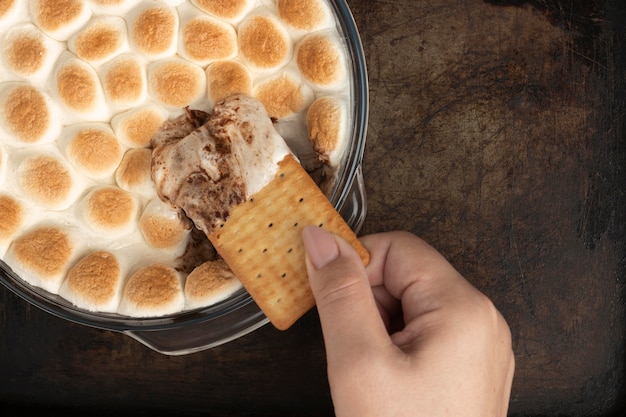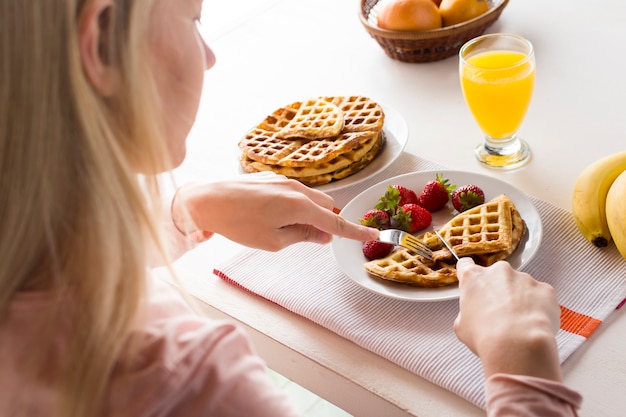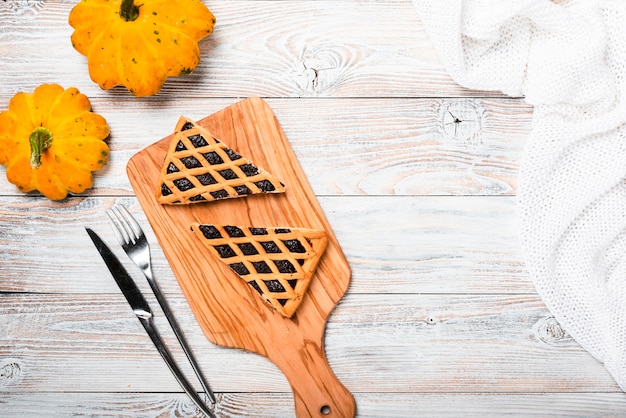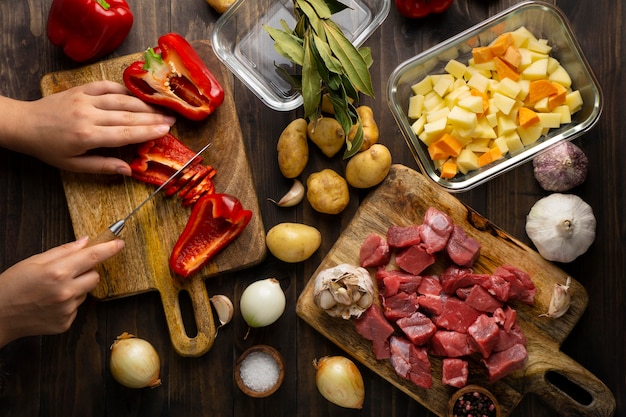There's a reason why waffles are a breakfast staple. They're versatile, comforting, and utterly delicious. From the classic, golden-brown squares enjoyed with a generous drizzle of syrup to the gourmet creations piled high with fresh fruit and whipped cream, waffles have the power to make any morning feel special. But achieving that perfect waffle, with its crisp exterior, fluffy interior, and even browning, requires more than just throwing a batter into a waffle maker and hoping for the best. It's about understanding your equipment, mastering the art of batter consistency, and knowing precisely how long to cook those little squares of joy to achieve ultimate deliciousness.
As someone who's spent countless hours experimenting with waffle recipes and perfecting my waffle-making technique, I'm here to share my secrets. Let's dive into the world of waffle-making, exploring the nuances of cooking time, troubleshooting common waffle woes, and even discovering some exciting variations to elevate your waffle game.
Part 1: The Foundation of a Perfect Waffle

Understanding Your Waffle Maker: A Guide to Your Kitchen Companion
The journey to the perfect waffle begins with a deep understanding of your waffle maker. Every model is unique, boasting its own personality when it comes to heating elements, non-stick coatings, and settings. This knowledge will empower you to make informed decisions about cooking time and achieve consistently beautiful results.
- Heating Elements: The Heart of the Waffle Maker
- Non-Stick Coating: The Key to Waffle Release
- Settings: Controlling the Heat and Time
Imagine your waffle maker as a tiny kitchen with multiple ovens. Some models feature multiple heating elements that distribute heat evenly across the plates, ensuring a consistent cook and a beautiful golden-brown exterior. Others, however, rely on a single heating element, which may take a bit longer to cook and can lead to uneven browning. Knowing whether you have a multi-oven or a single-oven system will guide your cooking time decisions.
A good non-stick coating is a waffle maker's best friend, ensuring that your waffles release beautifully and without sticking. If your waffle maker boasts a brand-new non-stick coating, a light spray of oil or a quick brush of melted butter is all you'll need. But if your waffle maker has seen better days and its non-stick coating is showing its age, you might need a little extra grease or consider using parchment paper or silicone baking mats to prevent sticking.
Modern waffle makers are like sophisticated little chefs, offering adjustable temperature and timer settings that give you complete control over the cooking process. Some even come equipped with pre-programmed settings for different waffle types, from classic Belgian waffles to luxurious Liege waffles. Understanding these settings will allow you to fine-tune the cooking process to your liking.
Choosing the Right Recipe: From Thin and Crispy to Thick and Fluffy
The recipe you choose is like the blueprint for your waffle. It determines the type of waffle you'll end up with, whether it's thin and crispy, ideal for a light and airy bite with a delicate crunch, or thick and fluffy, perfect for a substantial and satisfying breakfast.
- Thin and Crispy Waffles: These recipes, with their lean batter and focus on a delicate crunch, are best suited for shorter cooking times.
- Thick and Fluffy Waffles: These recipes, designed to create a substantial waffle with a soft and airy interior, will require a slightly longer cooking time to ensure that the centre is cooked through.
The Importance of Batter Consistency: The Key to Uniformity
Think of your waffle batter as a symphony of ingredients, each playing its own role in creating the perfect waffle. The consistency of your batter is paramount; it dictates how the waffles will cook and the overall texture you'll achieve. Ideally, your batter should be smooth, pourable, and just thick enough to hold its shape without being overly dense.
- Too Thick: A batter that's too thick will take longer to cook and could result in a dense, heavy waffle that lacks the airy texture you crave.
- Too Thin: A batter that's too thin will spread out excessively in the waffle maker, creating a thin, crispy waffle that may be too fragile to eat.
Remember, the goal is to find that sweet spot where the batter is just right—like Goldilocks' porridge! If your batter is too thick, simply add a touch of milk or water; if it's too thin, add a sprinkle of flour. Experiment until you've achieved the perfect consistency for your preferred waffle type.
Part 2: Mastering the Waffle-Making Process

Pre-heating Your Waffle Maker: The Importance of Getting Ready
Just as you preheat your oven before baking a cake, it's crucial to preheat your waffle maker before pouring in the batter. Preheating allows the waffle maker to reach its ideal temperature, ensuring that the waffles cook evenly and develop that beautiful golden-brown crust. Most waffle makers take 5-10 minutes to preheat, but always check the manufacturer's instructions for your specific model.
Greasing Your Waffle Maker: A Smooth Start for a Beautiful Finish
A light coating of oil or butter is a simple yet essential step in achieving beautifully browned and flawlessly released waffles. I find that a spritz of non-stick cooking spray or a thin layer of melted butter does the trick. If you're using a well-seasoned cast iron waffle maker, you might not need additional grease.
Pouring the Batter: The Art of Filling the Plates
Once your waffle maker is preheated, pour the batter into the centre of the waffle maker plates. Don't overfill; the batter will expand during cooking. A good rule of thumb is to fill the plates about 2/3 of the way full.
Closing the Waffle Maker: Patience is Key
Gently close the lid of your waffle maker and allow it to work its magic. Avoid pressing down on the lid, as this can create uneven cooking and potentially damage your waffle maker.
Checking for Doneness: The Signs of a Perfect Waffle
The cooking time for your waffle will depend on the specific model, recipe, and your personal preference for doneness. However, a good starting point is to check for doneness after 3-5 minutes.
- Visual Cue: Gently lift the lid and take a peek. The waffle should be a beautiful golden brown on the bottom and cooked through. If it's still pale or soft, close the lid and let it cook for another minute or two.
- Toothpick Test: Insert a toothpick or wooden skewer into the centre of the waffle. If it comes out clean, your waffle is ready.
Removing the Waffle: Carefully Releasing a Culinary Masterpiece
Once your waffle is cooked to perfection, carefully remove it from the waffle maker using a spatula or tongs. If your waffle is sticking, gently loosen it with a spatula and try removing it again. If it's still stubborn, let it cool for a minute or two before attempting to remove it again.
Part 3: Troubleshooting Common Waffle Problems

Even experienced waffle makers can encounter a few bumps in the road. Don't fret, as the solutions are usually quite simple:
1. Waffles Sticking to the Waffle Maker
- Solution 1: Ensure your waffle maker is properly greased. Use a thin layer of cooking spray or butter.
- Solution 2: Try a different type of cooking spray or butter. Some brands perform better than others in preventing sticking.
- Solution 3: If your waffle maker has a worn-out non-stick coating, consider using parchment paper or silicone baking mats to create a barrier between the batter and the plates.
2. Waffles Not Cooking Evenly
- Solution 1: Make sure your waffle maker is preheated. Allow it to reach the desired temperature before pouring in the batter.
- Solution 2: Double-check that your waffle maker is properly closed. A loose lid can disrupt the even distribution of heat.
- Solution 3: If your waffle maker has a single heating element, rotate the waffle halfway through the cooking process. This will help ensure that both sides cook evenly.
3. Waffles Too Crispy
- Solution 1: Reduce the cooking time. If your waffles are getting too crispy, check the doneness sooner and remove them from the waffle maker before they become overly browned.
- Solution 2: Reduce the temperature setting on your waffle maker. If your waffle maker allows you to adjust the temperature, try lowering it slightly.
- Solution 3: Try a recipe that is specifically designed for thin, crispy waffles. These recipes typically use less batter, which results in thinner waffles that cook faster.
4. Waffles Too Soft and Doughy
- Solution 1: Increase the cooking time. Give the waffles a few extra minutes to cook through.
- Solution 2: Increase the temperature setting on your waffle maker. If your waffles are still undercooked after the recommended time, try increasing the temperature slightly.
- Solution 3: Try a recipe that uses more flour or less liquid. Adjusting the batter consistency can help create a more firm waffle that cooks through more quickly.
Part 4: Making Waffles Ahead of Time
If you're a planner, you'll be pleased to know that waffles can be made ahead of time and reheated later. This is a lifesaver for busy mornings or when you want to have a head-start on breakfast.
- Cooling: Allow the cooked waffles to cool completely before storing them.
- Storage: Stack the cooled waffles between sheets of parchment paper in an airtight container. This will prevent them from sticking together and maintain their freshness.
- Refrigeration: Store the waffles in the refrigerator for up to 3 days.
- Freezing: For longer storage, freeze the waffles for up to 2 months.
- Reheating: To reheat frozen or refrigerated waffles, simply toast them in a toaster or oven for a few minutes.
Part 5: Adding Flavour and Texture
Once you've mastered the basic waffle recipe, it's time to unleash your creativity and explore the world of flavour and texture.
1. Incorporating Ingredients into the Batter
- Chocolate Chips: A classic addition, chocolate chips add a touch of sweetness and indulgence to every bite.
- Fruit: Fresh or frozen berries, chopped bananas, or diced apples add a burst of juicy sweetness and vibrant colour.
- Nuts: Chopped pecans, walnuts, or almonds provide a satisfying crunch and a hint of nutty flavour.
- Spices: A pinch of cinnamon, nutmeg, or cardamom adds a warm and aromatic dimension to your waffles.
2. Topping it Off: The Finishing Touches
The toppings are where you truly personalize your waffles. Let your imagination run wild!
- Sweet Delights: Whipped cream, fruit, syrup, chocolate sauce, powdered sugar, and nuts are all classic choices.
- Savoury Sensations: Waffles can also be enjoyed as a savoury treat. Try toppings like cheese, eggs, bacon, mushrooms, or even smoked salmon and cream cheese.
3. Sweet or Savoury: The Versatility of Waffles
Waffles are surprisingly versatile, catering to both sweet and savoury cravings. For a sweet breakfast, top your waffles with a medley of fresh fruit, fluffy whipped cream, and a drizzle of maple syrup. For a savoury lunch or dinner, create a mouth-watering waffle sandwich with cheese, bacon, and a fried egg, or indulge in a decadent smoked salmon and cream cheese creation.
Part 6: Waffle Maker Variations
The world of waffle makers is far more diverse than you might imagine, offering a range of options to suit every preference and culinary adventure.
1. Belgian Waffle Maker: The Classic Choice
Belgian waffle makers are known for their deep pockets and crisp exterior, creating thick, fluffy waffles with a delicious, airy texture. If you're seeking a waffle maker that delivers classic, restaurant-worthy waffles, this is the one for you.
2. Liege Waffle Maker: A Caramelized Delicacy
Liege waffle makers are designed specifically for a type of waffle that is traditionally made with pearl sugar. This sugar melts and caramelizes during the cooking process, creating a crispy, caramelized exterior and a chewy, gooey interior. These waffles are often enjoyed with a sprinkle of powdered sugar or a scoop of ice cream.
3. Pancake Maker: Beyond Waffles
Pancake makers are similar to waffle makers but feature round plates instead of square ones. They can be used to make a variety of pancakes, from thin and crispy to thick and fluffy. They also work well for making mini-pancakes, perfect for breakfast parties or snacks.
4. Square Waffle Maker: The Traditional Choice
Square waffle makers are the most common type of waffle maker and are perfect for making traditional waffles. They come in a variety of sizes and features, making it easy to find one that fits your needs and your kitchen space.
5. Mini Waffle Maker: Individualized Delights
Mini waffle makers are ideal for making small, individual waffles. They're perfect for quick breakfasts, snacks, or even desserts. They are also excellent for families with small children, as they allow each person to make their own waffle.
6. Griddle: A Versatile Kitchen Tool
Griddles are similar to waffle makers but have a flat surface instead of waffle plates. They can be used to make a variety of dishes, including pancakes, waffles, grilled sandwiches, and even vegetables.
7. Rotating Waffle Maker: Even Cooking with Style
Rotating waffle makers feature a rotating mechanism that allows you to rotate the waffle during cooking. This helps to ensure that the waffle cooks evenly on all sides. Rotating waffle makers are often used to make Belgian waffles, as they allow the waffle to develop a beautiful, golden-brown crust.
Part 7: Favourite Waffle Recipes
Here are two of my favourite waffle recipes that I often whip up at home. Both are easy to follow and produce delicious, fluffy waffles:
1. classic waffle recipe
This simple and classic recipe is perfect for beginners. It produces light and fluffy waffles that are excellent for sweet or savoury toppings.
Ingredients:
- 1 ?? cups all-purpose flour
- 2 tablespoons granulated sugar
- 2 teaspoons baking powder
- ?? teaspoon salt
- 1 ?? cups milk
- 2 large eggs
- ?? cup melted butter
- 1 teaspoon vanilla extract
Instructions:
- In a large bowl, whisk together the flour, sugar, baking powder, and salt.
- In a separate bowl, whisk together the milk, eggs, melted butter, and vanilla extract.
- Gradually add the wet ingredients to the dry ingredients, whisking until just combined. Avoid overmixing.
- Preheat your waffle maker according to the manufacturer's instructions.
- Grease the waffle maker with cooking spray or melted butter.
- Pour ?? cup of batter onto the hot waffle maker and close the lid.
- Cook for 3-5 minutes or until golden brown and cooked through.
- Remove the waffle and repeat with the remaining batter.
- Serve immediately with your favourite toppings.
2. Blueberry Waffles
This recipe is a delightful twist on the classic waffle. The blueberries add a burst of flavour and sweetness to the waffles. You can use fresh or frozen blueberries for this recipe.
Ingredients:
- 1 ?? cups all-purpose flour
- 2 tablespoons granulated sugar
- 2 teaspoons baking powder
- ?? teaspoon salt
- 1 ?? cups milk
- 2 large eggs
- ?? cup melted butter
- 1 teaspoon vanilla extract
- 1 cup fresh or frozen blueberries
Instructions:
- In a large bowl, whisk together the flour, sugar, baking powder, and salt.
- In a separate bowl, whisk together the milk, eggs, melted butter, and vanilla extract.
- Gradually add the wet ingredients to the dry ingredients, whisking until just combined. Avoid overmixing.
- Fold in the blueberries.
- Preheat your waffle maker according to the manufacturer's instructions.
- Grease the waffle maker with cooking spray or melted butter.
- Pour ?? cup of batter onto the hot waffle maker and close the lid.
- Cook for 3-5 minutes or until golden brown and cooked through.
- Remove the waffle and repeat with the remaining batter.
- Serve immediately with your favourite toppings.
Part 8: Waffle Maker Maintenance
Taking good care of your waffle maker will ensure that it remains a reliable companion in your kitchen for years to come. Here are a few simple steps for maintaining your waffle maker:
- Clean After Each Use: Wipe the waffle maker plates with a damp cloth after each use. If the plates are particularly dirty, you can use a mild dish soap and a sponge.
- Avoid Immersing in Water: Most waffle makers are not dishwasher safe. Immersion in water could damage the electrical components.
- Proper Storage: Store the waffle maker in a cool, dry place when not in use. Avoid stacking heavy items on top of it.
- Avoid Abrasive Cleaners: Don't use harsh cleaners or scouring pads on the waffle maker plates, as this can damage the non-stick coating.
Part 9: Waffle Fun Facts
Waffles have a rich history and have been enjoyed around the world for centuries. Here are a few fun facts about these beloved breakfast treats:
- The word "waffle" comes from the Dutch word "wafelen."
- The first waffle irons were made of iron and were heated over an open fire.
- Waffles were originally made with a batter of flour, water, and salt.
- The first waffle maker with interchangeable plates was invented in the 19th century.
- The waffle iron is the state food of New Jersey.
Part 10: FAQs
1. What is the best temperature setting for cooking waffles?
The optimal temperature setting for cooking waffles will depend on the type of waffle maker you are using and the recipe. Most waffle makers have a temperature range of 300-400°F. I recommend starting with a medium setting (around 350°F) and adjusting it based on your results. If your waffles are not cooking through, try increasing the temperature. If they are getting too crispy, try lowering the temperature.
2. How do I know when my waffle is cooked?
Your waffle should be golden brown on both sides and cooked through when it's ready. You can check for doneness by gently lifting the lid of the waffle maker and taking a peek. If it's still pale or soft, close the lid and let it cook for another minute or two. You can also use a toothpick or wooden skewer to test for doneness. Insert it into the centre of the waffle. If it comes out clean, your waffle is ready.
3. What if my waffle is sticking to the waffle maker?
If your waffle is sticking to the waffle maker, it's likely that the waffle maker is not properly greased. Make sure to grease the waffle maker plates with a light coating of cooking spray or butter before pouring in the batter. If your waffle maker has a worn-out non-stick coating, try using parchment paper or silicone baking mats.
4. Can I freeze waffles?
Yes, you can freeze waffles. Let the waffles cool completely and then stack them between sheets of parchment paper in an airtight container. You can store them in the freezer for up to 2 months. To reheat, simply toast them in a toaster or oven for a few minutes.
5. What are some creative toppings for waffles?
The possibilities for waffle toppings are endless. Here are a few of my favourites:
- Whipped cream and fruit
- Chocolate sauce and sprinkles
- Powdered sugar and maple syrup
- Caramel sauce and pecans
- Peanut butter and banana slices
- Sautéed mushrooms and goat cheese
- Fried eggs and bacon
- Smoked salmon and cream cheese
With a little practice and experimentation, you'll be able to make perfect waffles every time. So, fire up your waffle maker and get ready to enjoy the fluffy goodness!
Everyone is watching

Perfect Rice Every Time: The Ultimate Guide to Cooking Rice
Cooking TipsAs a self-proclaimed foodie, I've always been a bit obsessed with rice. It's the foundation of countless cuisi...

Ultimate Guide to Cooking the Perfect Thanksgiving Turkey
Cooking TipsThanksgiving. Just the word conjures up images of overflowing tables laden with delicious food, the scent of r...

The Ultimate Guide to Cooking Asparagus: Tips, Techniques, and Recipes
Cooking TipsAsparagus. The mere mention of this spring delicacy conjures up images of vibrant green spears, crisp and burs...

Can You Cook Spaghetti with Gasoline? (The Shocking Truth)
Cooking TipsWe've all seen those crazy internet trends. You know, the ones that make you wonder, "Did someone actually try...

Chorizo and Eggs Recipe: The Ultimate Guide
Cooking TipsRight, let’s talk about chorizo and eggs. You know, that classic Spanish dish that's always a winner. It's th...
